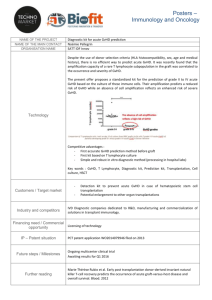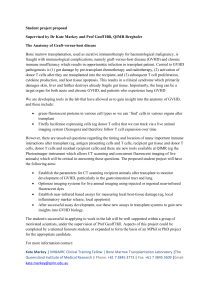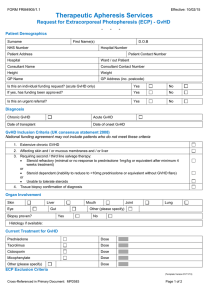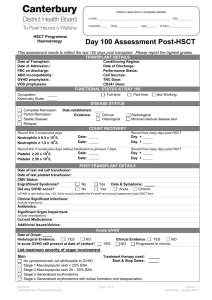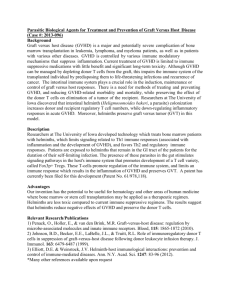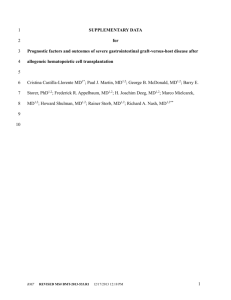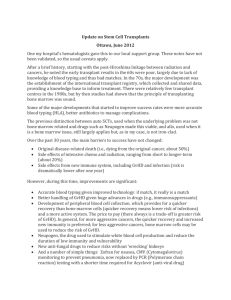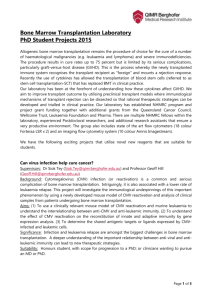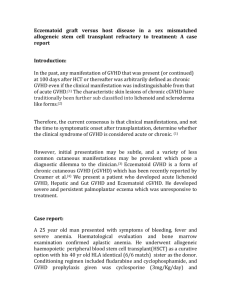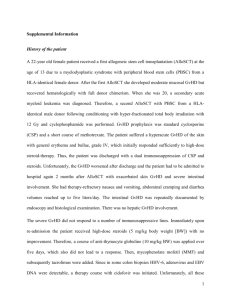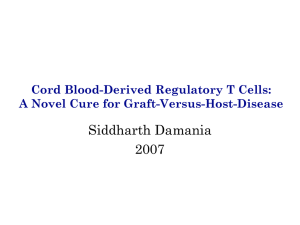Bone Marrow Transplantation - Wellington Intensive Care Unit
advertisement
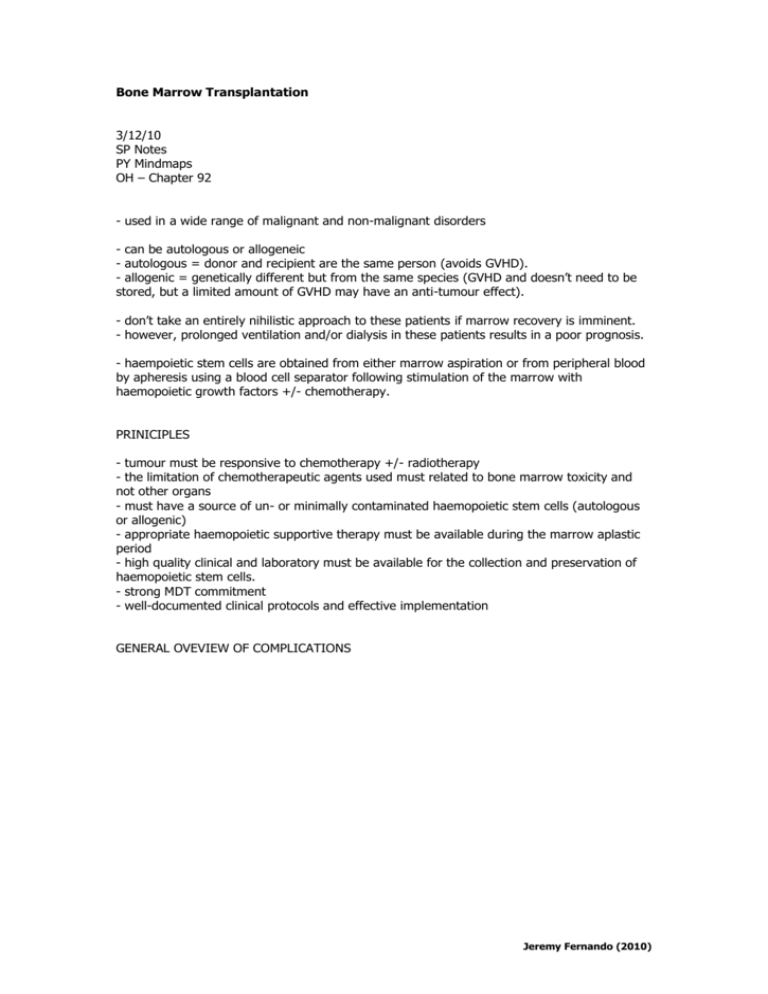
Bone Marrow Transplantation 3/12/10 SP Notes PY Mindmaps OH – Chapter 92 - used in a wide range of malignant and non-malignant disorders - can be autologous or allogeneic - autologous = donor and recipient are the same person (avoids GVHD). - allogenic = genetically different but from the same species (GVHD and doesn’t need to be stored, but a limited amount of GVHD may have an anti-tumour effect). - don’t take an entirely nihilistic approach to these patients if marrow recovery is imminent. - however, prolonged ventilation and/or dialysis in these patients results in a poor prognosis. - haempoietic stem cells are obtained from either marrow aspiration or from peripheral blood by apheresis using a blood cell separator following stimulation of the marrow with haemopoietic growth factors +/- chemotherapy. PRINICIPLES - tumour must be responsive to chemotherapy +/- radiotherapy - the limitation of chemotherapeutic agents used must related to bone marrow toxicity and not other organs - must have a source of un- or minimally contaminated haemopoietic stem cells (autologous or allogenic) - appropriate haemopoietic supportive therapy must be available during the marrow aplastic period - high quality clinical and laboratory must be available for the collection and preservation of haemopoietic stem cells. - strong MDT commitment - well-documented clinical protocols and effective implementation GENERAL OVEVIEW OF COMPLICATIONS Jeremy Fernando (2010) NEUROLOGICAL COMPLICATIONS - > with allogenic transplantation - risk factors: high dose chemotherapy, immunosuppression, GVHD, thrombocytopaenia CVA - median day of presentation = 28 - usually haemorrhage (intracerebral, SAH) from thrombocytopaenia - other causes: infarction from infection or thrombosis, non-bacterial endocarditis and embolism - high mortality (70%) - standard management CNS Infections - aspergillosis (main cause), CMV, HSV, Toxoplasma, Candida, Cryptococcus, bacterial meningitis - prognosis is extremely poor Metabolic Encephalopathy - > in allogenic transplantation - altered mental status, seizures, Wernicke encephalopathy (altered mental status, ataxia, opthalmoplegia) - causes: hypoxaemia, electrolyte abnormalities, metabolic acidosis, sepsis, hepatic failure, medications (sedatives and analgesics), thiamine deficiency - supportive care Jeremy Fernando (2010) Treatment related neurological complications - OKT3: aseptic meningitis (can decrease risk with corticosteroids) - cranial radiation - imipenem: seizures - corticosteroids: myopathy, psychosis - cyclosporine A: encephalopathy, leukoencephalopathy, generalised cerebellar dysfunction, hemiparesis, quadriplegia, seizures. Graft vs Host Disease - acute GVHD: encephalopathy associated with other organ dysfunction - chronic GVHD: polyneuropathy, polymyositis, MG - treatment: intensification of immunosuppressive therapy CARDIAC COMPLICATIONS Pulmonary oedema - commonest cardiac indication for ICU admission - risk factors: low EF, fluid overload, ARF, veno-occlussive disease, severe sepsis, anaemia and high dose chemotherapy Pericardial tamponade - rare - usually related to: cyclophosphamide toxicity, viral syndrome, chronic GVHD, renal failure, bacterial infection (rarely) Endocarditis - rare (1.3%) - clinical features are subtle: left sided murmurs, indwelling CVC’s, disruption of skin and mucosal barriers by high dose chemotherapy and GVHD - organisms: Staph aureus, Strep viridans, fungal, aseptic Arrhythmias - electrolyte abnormalities hypoxaemia sepsis MOF PULMONARY COMPLICATIONS - many reasons - bilateral pulmonary infiltrate differential = (1) Pneumonia Viral – CMV, HSV, VSV Bacterial – see Pneumonia in the Immunocompromised Document Fungal – Pneumocystis, Aspergillus, Candida Protozoa – Toxoplasma Jeremy Fernando (2010) (2) Engraftment syndrome (3) Bronchiolitis obliterans +/- organizing pneumonia (BOOP) (4) Diffuse alveolar haemorrhage (5) Idiopathic pneumonia syndrome - organisms causing infection are temporally distributed: -> early (< 30 days): bacteria, candida, aspergillus, HSV, RSV -> mid (30-100 days): CMV, PCP, adenovirus, HZV, aspergillus -> late (> 100 days): CMV GASTROINTESTINAL COMPLICATIONS GVHD of Intestine - clinical features: abdominal pain, N+V, diarrhoea, bleeding, may have peritonism, often associated with hepatitis and a skin rash (acute GVHD) - CT: bowel wall oedema - treatment: intensification of immunosuppressive therapy Intestinal Pseudo-obstruction - supportive and minimizing aggravating factors Veno-occlusive Disease of Liver - common - may be mild -> rapidly fatal (in 40%) - pathogenesis: thrombosis of the small central hepatic venules due to endothelial cell damage by high dose chemotherapy - clinical features: during first 21 days following transplant, weight gain, tender liver, jaundice - investigations: transaminitis, hyperbilirubinaemia, Doppler U/S showing reversal or diminished portal flow. - management: supportive, fluid restriction, diuresis, paracentesis, avoid infections and hepatotoxic medications, oral ursodeoxycholic acid (lowers biliriubin) possibly thrombolytics GI Bleeding - diffuse mucosal bleeding of the small intestine, mucosal ulcers and necrosis - causes: chemotherapy induced, GVHD, adenovirus, CMV - management: supportive, endoscopy (rarely required), surgery Enteritis - mild to self limiting -> severe dehydration, hypotension and ARF - causes: GVHD, bacterial infection (clostridia), viral infections (rotavirus, adenovirus, CMV, HSV, HZV) - treatment: supportive, octreotide (decrease secretory hormones), rotavirus (oral immunoglobulins) Intestinal Perforation Jeremy Fernando (2010) - causes: CMV ulcers, corticosteroids, GVHD - treatment: standard care Pancreatitis - rare - causes: medications (cotrimoxazole, corticosteroids, cyclosporine A), infections (CMV and adenovirus), GVHD, biliary sludge - treatment: standard Other Liver Disease - viral hepatitis: adenovirus, HSV, HZV, CMV, Hep B and C - acute GVHD: rarely producers fulminant liver failure - fungal infection: liver involvement of Candida and Aspergillus RENAL COMPLICATIONS - if develops the need for dialysis -> mortality 90% Tumour Lysis Syndrome - rare as tumour burden is reduced prior to transplantation - clinical features: hyperuricaemia, hyperkalaemia, hyperphosphataemia, hypocalcaemia, renal failure - treatment: IVF, allopurinol, rasburicase, phosphate binders, dialysis Infusion of Stem Cells - haemolysis -> haemoglobinuria -> proximal ATN -> ARF - treatment: hydration, alkalinsation Haemorrhagic Cystitis - risk factors: cyclophosphamide, busulfan, irradiation, viral infections - prevention: IVF, diuresis, irrigation of the bladder, mesna Veno-occlusive Renal Disease - clinical features: day 10-21 post transplant, hepatorenal syndrome - risk factors: mismatched graft, age > 25 years, pre-existing renal failure, sepsis, amphotericin B Drug Nephrotoxicity - cyclosporine A: intensive renal arteriolar vasoconstriction nitrourea methotrexate cyclophosphamide amphotericin B acyclovir foscanet aminoglycosides tacrolimus Jeremy Fernando (2010) INFECTIOUS COMPLICATIONS Viral - CMV: pneumonitis is the most lethal -> ganciclovir/foscarnet, Ig’s RSV: URTI->LRTI -> nasal wash/BAL, aerosolized ribavirin, Ig’s HSV-6: pneumonitis, marrow suppression, encephalitis -> ganciclovir/foscarnet HZV: pneumonia, hepatitis, skin rash, encephalitis, DIC -> high dose acyclovir Bacterial - risk factors: neutropenia, mucositis, skin breakdown, GI problems, IV catheters - organisms: gram negatives (Pseudomonas, Klebsiella), gram positives (MRSA, Strep viridans, enterococci) Fungal - invasive pulmonary aspergillus: lungs to haematogenous dissemination -> CXR: halo sign and air crescent sign, sputum, BAL, voriconazole/caspofungin - candida: fluconazole or caspofungin (evidence of endophthalmitis or resistant organisms) - PCP: rare now c/o co-trimoxazole prophylaxis -> requires a BAL SUMMARY Acute (< 30 days) – neutropenia - acute tumour lysis infection: bacterial, fungal and viral respiratory: engraftment, haemorrhage cardiovascular: CHF, arrhythmias, tamponade gastrointestinal: GIH, enteritis, veno-occlusive disease of liver nervous: CVA, encephalopathy other: haemorrhagic cystitis Early (30-100 days) – acute GVHD - graft failure pneumonitis BOOP infection: bacterial, viral, fungi Late (>100 days) – chronic GVHD - myopathy neuropathy HUS infection: CMV infertility second malignancy cataracts Jeremy Fernando (2010) PROGNOSIS - critical illness during engraftment period (< 30 days post BMT) -> mortality 33% - acute GVHD (moderate to severe) -> mortality 90% - more than two organ systems and need for mechanical ventilation/RRT are associated with very poor outcome. Jeremy Fernando (2010)
